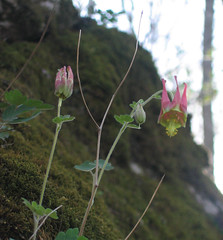The Wildflower Gardener
I’ve waxed rhapsodic about my neighbor, Tim, before. Among the many things I admire about him, is the wildflower garden he maintains in his backyard. It is a wooded, shady plot planted with native wildflowers, from trillium to jack-in-the-pulpit to bloodroot. A visit to Tim’s house almost always involves a trip to the shaded grotto to see something new blooming (and me leaving green with envy).
He obtained much of his stock from the land he owns near Lexington, KY. After hearing endless stories about the property’s charms, I finally got to visit the famed Kentucky get-away over Easter weekend. I left Tim’s land with a newfound appreciation for his dedication to wildflower cultivation.
I thought Tim’s home garden was impressive, but his Kentucky garden is even more so. Yes, Tim’s entire 75 acres of land, from sandstone ridge to limestone rise, is his personal wildflower cultivation zone. I have to admire the patience and fortitude of someone who would pay for wildflowers and then plant them in the middle of the woods, two-and-a-half hours from his house. Unlike the plants that I plant next to my front stoop to visit and coo over daily, Tim may or may not ever see his dainties in bloom again. He takes the gamble in order to perpetuate these natural beauties whose habitat is slowly being eroded elsewhere. The rewards, seeing a population of twinleaf take off and dozens of lady slipper orchids in bloom, must be worth it to him.
 We visited too early for the lady slippers, but the crested iris, anemones, chickweed, columbines, violets, and phlox were in bloom. Black and blue cohash were steadily unfurling from the forest floor. Trillium were excitedly carpeting the hillsides (and trails). The buckeyes and umbrella magnolia were in bud. Over all this, the redbud and dogwoods spread their pink and white canopies.
We visited too early for the lady slippers, but the crested iris, anemones, chickweed, columbines, violets, and phlox were in bloom. Black and blue cohash were steadily unfurling from the forest floor. Trillium were excitedly carpeting the hillsides (and trails). The buckeyes and umbrella magnolia were in bud. Over all this, the redbud and dogwoods spread their pink and white canopies.
I don’t know how Tim does it. Not only does he expend the effort to plant in the middle of nowhere, but he also manages to leave it all to come back to the city. I nearly grew roots and planted myself there.
Tim’s Kentucky Hideaway photo set
He obtained much of his stock from the land he owns near Lexington, KY. After hearing endless stories about the property’s charms, I finally got to visit the famed Kentucky get-away over Easter weekend. I left Tim’s land with a newfound appreciation for his dedication to wildflower cultivation.
I thought Tim’s home garden was impressive, but his Kentucky garden is even more so. Yes, Tim’s entire 75 acres of land, from sandstone ridge to limestone rise, is his personal wildflower cultivation zone. I have to admire the patience and fortitude of someone who would pay for wildflowers and then plant them in the middle of the woods, two-and-a-half hours from his house. Unlike the plants that I plant next to my front stoop to visit and coo over daily, Tim may or may not ever see his dainties in bloom again. He takes the gamble in order to perpetuate these natural beauties whose habitat is slowly being eroded elsewhere. The rewards, seeing a population of twinleaf take off and dozens of lady slipper orchids in bloom, must be worth it to him.
 We visited too early for the lady slippers, but the crested iris, anemones, chickweed, columbines, violets, and phlox were in bloom. Black and blue cohash were steadily unfurling from the forest floor. Trillium were excitedly carpeting the hillsides (and trails). The buckeyes and umbrella magnolia were in bud. Over all this, the redbud and dogwoods spread their pink and white canopies.
We visited too early for the lady slippers, but the crested iris, anemones, chickweed, columbines, violets, and phlox were in bloom. Black and blue cohash were steadily unfurling from the forest floor. Trillium were excitedly carpeting the hillsides (and trails). The buckeyes and umbrella magnolia were in bud. Over all this, the redbud and dogwoods spread their pink and white canopies.I don’t know how Tim does it. Not only does he expend the effort to plant in the middle of nowhere, but he also manages to leave it all to come back to the city. I nearly grew roots and planted myself there.
Tim’s Kentucky Hideaway photo set


2 Comments:
Oh, I love folks like Tim. We need more of them. Wonderful to know that somebody's creating a haven for these flowers.
The 'not rose' is Quince.
Post a Comment
<< Home